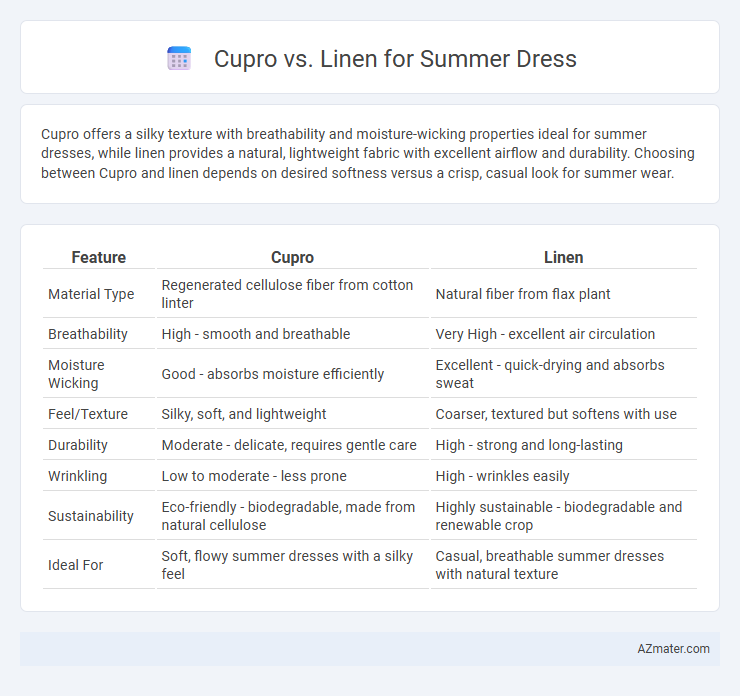Cupro offers a silky texture with breathability and moisture-wicking properties ideal for summer dresses, while linen provides a natural, lightweight fabric with excellent airflow and durability. Choosing between Cupro and linen depends on desired softness versus a crisp, casual look for summer wear.
Table of Comparison
| Feature | Cupro | Linen |
|---|---|---|
| Material Type | Regenerated cellulose fiber from cotton linter | Natural fiber from flax plant |
| Breathability | High - smooth and breathable | Very High - excellent air circulation |
| Moisture Wicking | Good - absorbs moisture efficiently | Excellent - quick-drying and absorbs sweat |
| Feel/Texture | Silky, soft, and lightweight | Coarser, textured but softens with use |
| Durability | Moderate - delicate, requires gentle care | High - strong and long-lasting |
| Wrinkling | Low to moderate - less prone | High - wrinkles easily |
| Sustainability | Eco-friendly - biodegradable, made from natural cellulose | Highly sustainable - biodegradable and renewable crop |
| Ideal For | Soft, flowy summer dresses with a silky feel | Casual, breathable summer dresses with natural texture |
Introduction: Comparing Cupro and Linen for Summer Dresses
Cupro, a regenerated cellulose fiber derived from cotton linter, offers a silky texture and excellent breathability, making it a popular choice for summer dresses. Linen, made from flax fibers, is renowned for its natural moisture-wicking properties and lightweight durability, ideal for hot climates. Both fabrics provide comfort and style, but cupro delivers a smoother finish while linen emphasizes a breathable, textured look.
Fabric Origins: What is Cupro? What is Linen?
Cupro, also known as cuprammonium rayon, is a regenerated cellulose fiber derived from cotton linter, the short fibers surrounding cotton seeds, chemically dissolved and reformed into a silky smooth fabric. Linen, on the other hand, is a natural textile made from the fibers of the flax plant, prized for its breathability, durability, and crisp texture. Both fabrics offer distinct summer dress qualities, with cupro providing a soft, luxurious feel and linen delivering lightweight, moisture-wicking comfort rooted in its botanical origin.
Breathability and Comfort in Hot Weather
Cupro offers excellent breathability due to its natural cellulose fibers, making it soft and moisture-wicking, ideal for hot weather comfort. Linen excels in allowing air circulation with its loosely woven texture, providing superior cooling and quick drying properties. Both fabrics enhance summer dress comfort, but Cupro's silky smooth feel contrasts with Linen's more textured, crisp finish.
Moisture-Wicking and Cooling Properties
Cupro fabric, derived from regenerated cellulose fibers, excels in moisture-wicking by rapidly absorbing and releasing sweat, making it ideal for summer dresses. Linen, made from flax fibers, offers exceptional breathability and natural cooling through its loose weave, allowing air to circulate freely and evaporate moisture efficiently. Both materials provide superior cooling properties, but Cupro's silky texture enhances moisture management, while linen's durability and crisp feel create a classic summer silhouette.
Texture and Feel Against the Skin
Cupro fabric offers a silky, smooth texture with a lightweight, breathable feel that drapes elegantly against the skin, making it ideal for summer dresses requiring fluid movement and softness. Linen features a crisp, slightly coarse texture that allows excellent airflow and moisture-wicking, providing a cooling sensation but may feel stiffer and rougher on sensitive skin. Both fabrics excel in breathability, but Cupro's luxurious smoothness offers enhanced comfort, while Linen delivers natural, textured durability suited for casual summer wear.
Durability and Longevity of Summer Dresses
Cupro offers excellent durability and a smooth, silk-like texture that maintains its shape and color after multiple washes, making it ideal for long-lasting summer dresses. Linen, while breathable and naturally moisture-wicking, tends to wrinkle easily and may weaken over time with frequent use and washing. For summer dresses prioritizing longevity and consistent wear, cupro provides a sturdier fabric choice compared to linen's delicate fibers.
Sustainability and Eco-Friendliness
Cupro, a regenerated cellulose fiber made from cotton linter, offers a sustainable alternative to traditional fabrics due to its biodegradable nature and use of cotton waste, reducing textile waste and environmental impact. Linen, derived from flax plants, is highly eco-friendly because flax requires minimal water and pesticides, and the entire plant is utilized, promoting zero waste. Both fabrics are breathable and biodegradable, but linen's natural cultivation process and lower water footprint often make it more sustainable for summer dresses in eco-conscious wardrobes.
Care and Maintenance Requirements
Cupro fabric requires gentle hand washing or dry cleaning to maintain its silky texture and prevent shrinking, with low heat ironing recommended to avoid damage. Linen is highly durable and machine washable, but it wrinkles easily and may need frequent ironing at high temperatures to keep a crisp, fresh look. Both materials benefit from air drying to preserve their shape and longevity during the hot summer months.
Style Versatility and Aesthetic Appeal
Cupro offers a smooth, silk-like finish that enhances style versatility with its elegant drape, making it ideal for both casual and formal summer dresses. Linen's natural texture and breathable fibers provide a relaxed, timeless aesthetic perfect for effortless, chic summer wear. Choosing between Cupro and Linen hinges on the desired look: Cupro delivers sophistication and sheen, while Linen emphasizes rustic charm and lightweight comfort.
Price Comparison and Overall Value
Cupro fabric tends to be more expensive than linen due to its complex production process involving regenerated cellulose fibers, which results in a silk-like feel and smooth drape. Linen is generally more affordable and offers exceptional breathability and durability, making it a cost-effective choice for summer dresses. Considering overall value, cupro provides a luxurious texture and elegance that justify its higher price, while linen delivers practical comfort and resilience at a lower cost.

Infographic: Cupro vs Linen for Summer Dress
 azmater.com
azmater.com